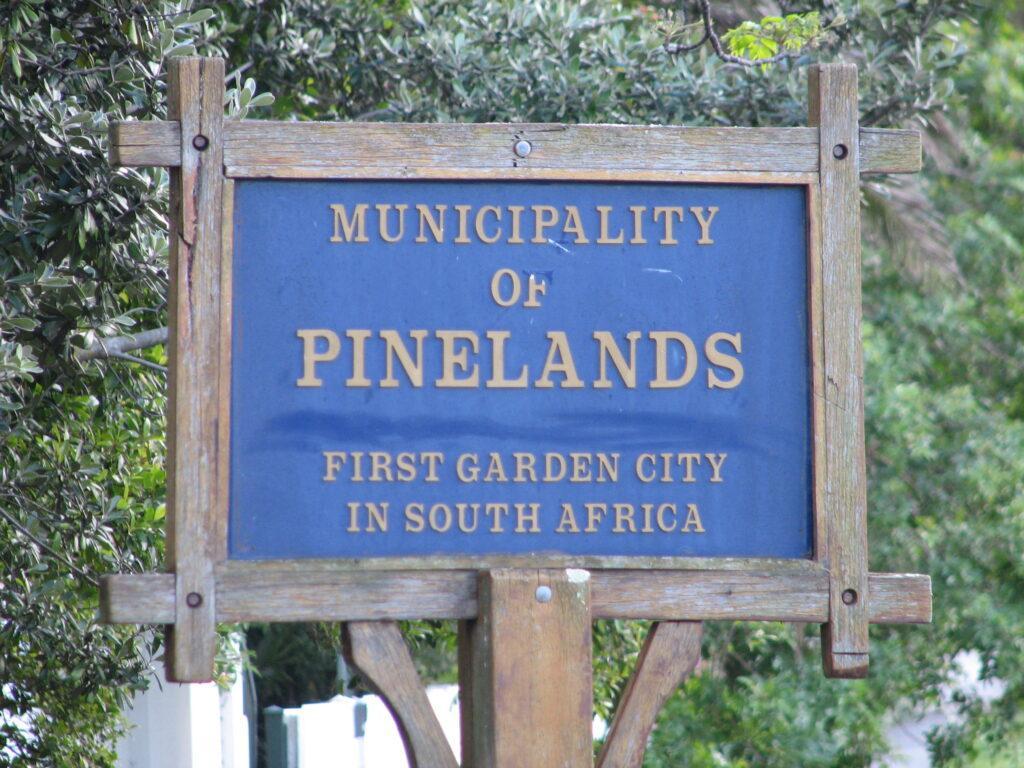- SOUTH AFRICA’S FIRST GARDEN CITY
- ORIGINAL BOOK
- PINELANDS FOCUS – 75YR COMMEMORATION
- PINELANDS CELEBRATES 90 YEARS
- PINELANDS CELEBRATES 100 YEARS
- FIFTY YEARS OF HOUSING BOOK
- ODE TO PINELANDS
- 7 NOV 2006 NEWSPAPER
- PINELANDS BUS COMPANY
- COMMUNITY FAIRS IN 1940
- PINELANDS LIBRARY 100 YEARS OLD
- PHOTOS FROM ORIGINAL BOOK
- MY FULL SET OF PHOTOS ON FLICKR
- OLD WOODEN BRIDGE
SOUTH AFRICA’S FIRST GARDEN CITY
This text is reproduced from an old booklet dating back to the 1950’s (PDF of the original below this text) written by Eric Rosenthal and printed in Gravure by Cape Times Limited. Note the language may be slightly antiquated, and the present tense refers to that period. Unfortunately, I have no cover page for the booklet any more, so I cannot obtain further details. It is a fascinating look into the reasons for the establishment of the Garden City concept, and also casts light on the history of some old Pinelands Buildings and street names.
***UPDATE 20 Feb 2012: Added additional history at bottom of the page ***
PINELANDS, the first Garden City in South Africa, attained a new stage in its history during 1948 when it became a full-fledged municipality, equal in status to the larger cities in the Union. With a population of more than 5,000 Europeans it now takes its place as one of the happiest and most enterprising communities in the land, while for beauty of situation and almost uniformly high standard of architecture and town-planning there is hardly anything to be compared with it. All this is the achievement of barely thirty years of work by a group of citizens of whose activities far too little is known. Hence, it is high time that the story of Pinelands, as well as the manner of its growth and operation, should become better known to South Africans.
Long before the expression “Garden City” had ever been thought of, back in Victorian times, the old Cape Colonial Government laid out a forestry estate on the outskirts of Cape Town. The farm was called ” Uitvlugt” and extended for several thousand acres across the sandy and still desolate Cape Flats. Here the Forestry Department carried out its task of planting pine trees— thousands and tens of thousands of them. From an economic point of view their effort was not a success, but it led to greater things and accounted for the name now bestowed upon the place, namely Pinelands.
Far away across the seas an English social reformer had a vision. He was Ebenezer Howard, who, born in 1850 and growing up with opportunities of studying the monotony, ugliness and grime of earlier manufacturing towns, conceived the idea of surrounding homes and workshops with gardens and green belts; of replacing tenements with homes standing in their own grounds; of diverting heavy traffic into main roads; of insisting on standards of architecture calculated to maintain the beauty of the original site; of segregating shops, factories and offices in areas where they could easily be reached by workers, and where they yet would not spoil the landscape; and of maintaining the contact between town and country even when industries developed. Howard did more than have visions. He set them down in a series of books, of which the most famous is called “Garden Cities of Tomorrow”, and early in the twentieth century he found his chance to build according to his ideas. Like other reformers, Howard encountered opposition and mockery. His ideas were described as crack-brained, as impracticable and, above all, as unpayable. Despite all this, however, those who read his works were more and more impressed. His views were reinforced by those of Sir Raymond Unwin and in 1899 a great area, near the town of Hitchin, was taken over as the site of the first real-life Garden City. Today, Letchworth, in Hertfordshire, has a population of about 15,000 and a large number of flourishing industries. It covers 4,000 acres and is operated by a utility company with a capital of £300,000.
“A prosperous working community, living and labouring under morally and physically healthy conditions’ ‘—thus its purpose has been described. So successful did Letchworth prove that other places in England followed the example, notably Welwyn Garden City, north of Hatfield, which has now nearly 10,000 people, and Hampstead Garden Suburb, north of London. Elsewhere the ideas of Sir Raymond Unwin bore fruit in individual suburbs as well as in factory housing, while both in America and on the Continent many further developments took place.
This was the position when a leading South African, the late Richard Stuttaford, became interested in Garden Cities (see an interesting history of the Stuttaford family and business here). Well known as the head of an important departmental store, as one of the most progressive farmers in the country and later as a Cabinet Minister, Mr. Stuttaford always felt a strong urge to help in making life easier for his own staff in particular as well as for the ordinary man in general. Fascinated by the writings of Ebenezer Howard, Sir Raymond Unwin and their successors, he took the opportunity, while on a visit to Britain at the end of World War I, to study the question at first-hand and came back to the Union resolved to start the Garden City movement here.
Only a short while before the dreaded Spanish Influenza Epidemic of 1918 had carried off tens of thousands of lives in the Union, including thousands in the Cape Peninsula, and Mr. Stuttaford, appalled at what he had seen, became convinced that better housing might have saved many of them. What he had in mind, is best set out in his own words.
“During the final years of the Great War rents increased so much as to create hardship for the poorer and middle classes, and the high level of prices for building materials prevented the erection of houses which could be rented at a reasonable sum. In this crisis the Government passed a Rent Act preventing exploitation of the public, but whilst this helped those already in occupation of houses it failed to help those who were homeless. I recognised that the Rent Act was only a palliative and that the only real remedy was the supply of houses sufficient to meet the demand. I also recognised that in the hurry to get houses built, it was only too probable that inferior houses would be run up by speculative builders in ugly blocks and in congested areas which would soon deteriorate and result in an increase of the slum problem, which was then and still is a disgrace to Cape Town, in common with all the large cities of the Empire. I hoped that in the new outlook at the end of the War it might be possible to inaugurate a new policy in providing homes for the people. In January, 1919, I interviewed the Acting Prime Minister, the Rt. Hon. F. S. Malan, and offered to give the necessary capital to develop an area of land according to my views if the Government, on its part, would make a grant of a portion of the Uitvlugt Forest Plantation for the same object. The Government of the day accepted my offer. The Garden Cities Trust was formed and I was fortunate in getting a body of prominent public-spirited Cape Town men to act as my co-trustees in addition to the Government trustees, who have always taken a keen interest in the work. My policy differs fundamentally from the ordinary policy pursued in the development of land for building purposes. The old method is that the land is cut up and developed with the single aim of bringing the utmost return to the original owner within the shortest space of time; the results, as seen all over the world, are crowded dwellings, the narrowest streets allowed by the local authority, want of air space and recreation space and sometimes no provision even is made for the proper making up of the roads. I maintain that from a public point of view this is economically unsound. In the future it costs vast sums in widening streets and in sanitary and other control, but, what is more important, it all tends to fill our hospitals with sickly children and physically unfit adults and creates breeding places for infectious diseases. It also necessitates many other additional costs, such as police control, etc. For these reasons I consider an entirely opposite policy of land development should be followed. I believe that with reasonable intelligence and foresight on the part of local authorities, and the grant to them of the right to purchase land on their borders in addition to the more sparsely-populated districts within their areas, it is possible to develop land in such a manner, that, while realising a fair price for the land, the area can be laid out solely in the interests of the future inhabitants and of the town generally. If the community also retains for its own benefit a considerable portion of the income derivable from commercial sites that will supply the necessary money for the provision of sites for recreation and similar purposes. Garden Cities have been given this opportunity and it is the Directors’ duty and privilege to prove that my ideal can be carried out in practice, is beneficial to the Community and is economically sound, and, having done this, to induce other local bodies to adopt the same principle, placing the results of our experience at their disposal and, where advisable, undertaking the development of further areas of land. Under the free grant of the land made by the Government, Garden Cities is under the further obligation to assist in the erection of houses for all classes of the people.”
The Department of Forestry having decided that “Uitvlugt’ was no longer an economic proposition, negotiations began for the transfer of the whole area to the Department of Lands.
On January 13,1919, the Union House of Assembly passed a resolution authorising the grant of “Uitvlugt” to a new body which was to be called “The Garden Cities Trust” and the measure was ratified six days later by the Senate.
Money was needed to launch the whole undertaking and Mr. Stuttaford made a free gift of £10,000 which was to serve as self-renewing capital for the enterprise. From the start “Garden Cities Trust” was designed not to operate for profit, a principle from which it has never departed. Its first members were Mr. Stuttaford himself and a group of other prominent Capetonians, Mr. Ralph W. Close, K.C., in his lifetime Minister for the Union in Washington, Mr. E. S. Steytler, Mr. E. R. Syfret, as well as the Union Secretary for Public Works, the Union Secretary for Lands and the Chief Conservator for Forests in their official capacities. This body entered into an agreement with Colonel Hendrik Mentz, Minister of Lands, on behalf of the Union Government, under which portion of the farm “Uitvlugt”, covering 367 morgen was transferred to it. “The main purpose of the Trust”, said the agreement, “is to provide better housing and better social conditions for the people, the latter purpose to be construed in its widest sense. The land has been granted for the purpose of establishing thereon and developing a township on the lines of modern Garden Cities. All moneys derived by the Trustees from their operations shall be devoted solely to the purposes of the Trust.” Stringent conditions were laid down to ensure that no speculation should ever take place in land and to encourage bona fide home-seekers. What is more, plot-holders were to be given a chance of electing members of the Board of Trustees, the first one to be chosen when 200 residences were in existence. The next 500 house-owners were to choose a second trustee, and so on, up to a maximum of four. Money could be raised by the Trust and could be lent out at the lowest possible rates of interest to persons wishing to establish their homes. No land, however, was to be sold for commercial purposes. It could only be leased and was so “to continue in perpetuity”. For the benefit of the community, the Trust was also authorised to carry on any trade considered necessary in the interest of purchasers or lessees.
Now that the site had been found, it became necessary to settle the vital question of who was to design the future Garden City. Since South Africa as yet had no experience in this field, it was resolved to import an overseas expert, Albert John Thompson, an architect and surveyor, who had been responsible, amongst other work, for Swan Pool Garden City, near Lincoln. Mr. Thompson arrived late in 1920 and on November 19 of that year took up his new duties. Working in collaboration with the Forestry Department, the Lands Department, the Cape Town Municipality, the Surveyor-General’s Department and others, he lost no time in planning the first section of the estate.
Two Pinelands veterans of those days deserve special mention. As early as June, 1919, Mr. Stuart Home, who had taken a deep interest in the project from the start, became the first Secretary. He continued in office for nineteen years, until June 30, 1938, when he retired and even now his link with the Garden City is not completely severed. Not long after Mr. Home’s original appointment on December 16, 1920, another pioneer official came to Pinelands, namely, Mr. J. W. P. Logan. He was the original Overseer and was promoted to Estate Manager, as which he continued fill 1945, when he retired.
Roads were cut and wherever possible the original pines were preserved. Great care was taken to ensure that even the smallest lanes should offer a beautiful vista—either a distant view of Table Mountain or perhaps an attractive cluster of trees. A complete departure was made from the hackneyed South African chessboard layout. Where possible, roads followed the contours of the ground, so as to ensure the most economical cost of construction; traffic was concentrated on arterial avenues and maximum safety ensured for children by setting back as many houses as possible in lesser thoroughfares. The business region was carefully defined, so that the shops would be near at hand without being obtrusive. Above all, the houses were designed to combine attractive appearance with comfort and low cost. Because the Garden City did not intend to make a profit, a generous margin on loans could be allowed. South Africa had just established its first Government-aided housing system, and, the Pinelands Local Board, founded soon after under the Cape Local Boards Ordinance, took advantage of the new facilities to raise loans with assistance from the State. In pine -war days it was possible to obtain a house at Pinelands for a down payment of £40 or £50. This state of affairs has unfortunately for the time being passed away, but as will be shown later, good progress is being made towards restoring it.
Immediately the Pinelands Local Board secured its first loan from the State a programme was taken in hand for the construction of “up to 15 houses” — forerunners of well over 1,600 standing to-day. Mr. Thompson had laid out the whole area of 800 acres in the rough, and the estate itself was opened up in sections. Mistakes made at the outset could thus be remedied in the light of experience. The first plots were sold for as little as £20 each. Electric power and water lines were carried from Cape Town into the area while a new station was laid out on the Cape Flats railway line. Today there are five of them, with two more projected on account of the great extent of the township. Although the first houses in Pinelands were mostly thatch-roofed there is to-day a very wide range of styles, varying from the old Dutch to the modernistic. The basic criterion is always whether it harmonises with the landscape.
By January, 1923, the whole sum of £15,000 from the Government housing loan had been invested, of which, however, only £3,000 was required to be paid down by the homeowners themselves. The original cost of plots was £6 19s. per 1,000 square feet as against £25 per 1,000 square feet today.
Like most new enterprises Pinelands had its teething troubles, yet slowly but surely the number of settlers increased. The functions of the Garden Cities Trust (which later changed its name to “Garden Cities”) on the one side and of the Pinelands Local Board on the other were clearly defined. One unique provision of the Cape Local Boards Ordinance expressly exempted all the land held by Garden Cities from Local Board and Divisional Council Rates — a striking recognition of its non-commercial character. Garden Cities was (and is) responsible for the construction of roads to the macadamised stage, including the kerbing and channeling, the provision of all storm-water drainage, the leveling of all plots, fencing, the establishment of playgrounds, sports facilities and open spaces as well as for the provision of school sites, and, for the planning of the area, much attention being devoted to a close scrutiny of all building plans.
During its existence (which terminated in 1948 with its conversion to a municipality), the Pinelands Local Board comprised three members, one appointed by Garden Cities, one by the Administrator of the Cape and one elected by the Ratepayers, charged with the powers of installing water reticulation, sewerage, the arrangements for road -sweeping and cleansing as well as with the removal of house and garden refuse. It also dealt with street lighting and the maintenance (not the making) of roads and footpaths. By special arrangement the Cape Town City Council handled the disposal of sewage and furnished electric current from its own stations. Revenue was raised by a general purpose rate of 31d. in the pound, plus a sewerage charge of approximately ld. in the pound. In addition, the Divisional Council imposed a rate of Id. in the pound.
It was in 1930 that Mr. Stuttaford decided to supplement the original system of Government loans by founding the Pinelands Development Company. Although it only had a nominal capital of £10,000, its function was extremely important, since it gave second bonds by which the gap between the 80% limit of the Government advances and the restricted means of the salaried man could be more effectively overcome. The Pinelands Development Company could grant another 15% of the cost of the houses, and did so at very reasonable rates of interest. Under the Union Housing Act the Pinelands Development Company was recognized as a Public Utility Company entitled to Housing Loans. Originally, the Government loan interest was 5% yearly, which later dropped to 4% and now stands at 3%. Monthly repayments of the second bond were provided for at the outset, bearing interest at the rate of 8% but now only at 6½%. The Board of this new concern was a small and efficient one,’ comprising Mr. Stuttaford himself, Mr. J. H. Bowes and Mr. E. Stubbs, while the management was placed in the capable hands of Mr. E. G. Pettit. Even more important than its financial operations were the building activities. Contractors were employed to put up homes of three, four and five rooms, and in 1939 such progress had been made that it was possible to provide a five-roomed house for £1 ,000 (including the cost of the land). No fees are paid to the Directors either of Garden Cities or of the Pinelands Development Company.
Considering the increase in costs during World War II the prices now obtaining remain surprisingly low. Almost at the very moment that Japan surrendered, in August, 1945, the Pinelands Development Company began building houses for ex-servicemen, not through a contractor but on its own account. It purchased the materials in bulk, employed its own architects, and took on a large staff of expert workmen. From August, 1945, to the end of December, 1947, the Company put up no fewer than 224 homes, which were sold at an average cost (including that of the land and legal expenses) of £2,500 each. Only 10 per cent. of this, that is to say, £250, had to be put down by the buyer, the remainder being furnished under the new system by the National Housing and Planning Commission, which has replaced the old National Housing Board. By giving a second bond for 5 per cent. of the cost, the Pinelands Development Company reduced the cash investment for many ex-servicemen to £125, which was well within the limits of their gratuities. No wonder that a long waiting list came into existence and that in a little over two years homes to the value of well over £500,000 went up under this scheme.
The highest standards of design and workmanship have always been maintained. Both single and double –storied types were produced and no two houses are exactly alike. Some are tiled, others roofed with thatch, slate or shingles. This variety of homes includes some with three bedrooms, plus lounge and dining recess; others with three bedrooms, lounge and a separate dining-room; two bedrooms, lounge and dining recess and with two bedrooms, lounge and separate dining room. Kitchens are completely fitted up, provision being made for the installation of electric stoves and refrigerators. The second part of the programme is now under way and 275 further houses are being built on the newer section of the estate. Today the Pinelands Development Company employs 640 building workers and has a pay roll of £3,000 a week, while its annual expenditure is in the neighbourhood of £300,000! Its store yards, covering three acres, are crammed with timber, steel reinforcement rods, tiles, plumbing requirements and a hundred other types of building material. It operates an impregnation plant of its own, at which all woodwork, whether for door frames or other items, is immersed in pentachlorophenol to forestall the ravages of the Italian beetle. It makes many of its own fittings and other articles, such as pre-cast concrete lintels. It has its own plumber’s shop, electrician’s shop and numerous other departments. Altogether the material in store at any given moment is valued at about £40,000. One may now drive for miles through streets of new houses; the gardens are already growing fast and the only restrictive factor is shortage of labour.
Pinelands today is a living, rapidly-growing community, which embodies the ideals of Ebenezer Howard, of Raymond Unwin and of Richard Stuttaford. Let us go on a tour round the place. We may travel there by bus from Mowbray Station or by one of the many electric trains on the Cape Flats Line, which skirts the estate on the west, while on the north runs the main line. We may get off at Oude Molen, Pinelands or Raapenberg Stations on the former route or at Woltemade No. 1 or Woltemade No. 1a on the latter. Wherever we go we shall see one of the world’s most magnificent backdrops, Table Mountain, Devil’s Peak and Lion’s Head. As soon as we leave one of the railway buildings we find ourselves among neat homes, most of them typically South African in design. All stand in their own gardens and it is easy to recognise the pride of the owners, as shown in the charm of the flowerbeds, lawns, hedges and pergolas. Traffic on the main roads is considerable, particularly on Forest Drive and Central Avenue, which leads into Union Avenue and Victory Avenue, but everywhere the playgrounds for children are safe and near their homes, and parents feel a minimum of anxiety in sending them to school. (Incidentally, there are to-day 586 boys and girls attending the two local institutions—516 at Pinelands Primary School and 70 at Scan Lea, a private establishment.) In the near future a high school will be built to meet an urgent demand.
A good place from which to survey Pinelands is the Civic Centre, which has not been laid out in any haphazard way, as so often happens in South Africa, but which is fronted by a range of handsome buildings, all set between lawns and flower beds in true Garden City style. On this Central Square an inscription commemorates a great day in local history. “This stone”, it says, “was laid on the 5th May, 1923, by Lieutenant-General the Rt. Hon. J. C. Smuts, P.C., C.H., D.T.D., K.C., to commemorate the founding of Pinelands, the first Garden City to be established under the trust formed by the Union Government and Richard Stuttaford of Cape Town.
Dominating the place is the block of administrative buildings occupied by Garden Cities and the Pinelands Development Company. It is of two stories and was constructed at a cost of £14,000 by the Pinelands Development Company. Here are all the offices from which the great programme of construction is controlled — secretarial, engineering, planning and other. All this is in striking contrast to the modest little wooden structure which served as the original estate office over 20 years ago and which is still used as the Wattle House Tea Room. Across the road from the administrative buildings of Garden Cities is the home of the Pinelands Municipality, a single-storied block with a circular Council Chamber. Here, too, the representatives of the community meet at a “round table” in true democratic style. Apart from the Mayor, Councillors, Town Clerk, Town Engineer and officials, the block in another wing provides a home for a library with a stock of 10,000 volumes, of which 2,000 are specially for children.
Social work of a most valuable kind is also carried on in this building, where the Pinelands Mothercraft Circle meets on the second and fourth Mondays of every month. A clinic for babies and small children is held in the afternoon, while on other Mondays provision is made for the weighing of infants. Mothers have their own club, which also meets here in the evening of the first Friday of every month.
The picturesque group of churches stands within a stone’s throw of each other. That of the Anglicans has a thatched roof and is adjoined by a large Girl Guide Hall, the foundation stone of which was laid on February 22, 1941, by Mrs. Kate Whitford Griffiths, long a “fairy godmother” of the community. Owing to the the rapid growth of the neighbouring school this hail is used during the week to accommodate extra classes. There is also a Scout Hall near the Civic Centre. Nearby stands the Methodist Church and Hall, the shingle-roofed Presbyterian Church, of which the foundation stone was laid on November 12, 1938, by Mr. A. B. McDonald. The Dutch Reformed place of worship is newer still, dating from 1942 and is dominated by a tower.
In contrast with the churches, but not less handsome, is the Police Station, done in the old Dutch style with red tiles and white gables (My Note: The building has been sold and is no longer used as a police station, but it still stands in its original state – Jan 2011).
The Pinelands Co-operative Society not only occupies one of the finest buildings in the municipality, but enjoys a unique position commercially (My Note: This was later the Beehive Supermarket, where I worked, and today it is a Kwikspar – Jan 2011). Its premises are leased from Garden Cities, who erected them for this purpose. At present it is the only shop in the area and since opening on August 1, 1946, it has grown at an astonishing rate. Today its 1,357 shareholders represent 97 per cent, of all the householders in Pinelands and the original staff of 20 has grown to 48. The double-storied building has its sales departments on the ground floor, devoted to groceries, hardware, drapery, fruit and vegetables, while there is also a ladies’ hairdressing saloon. Upstairs are five flats which have been allocated to ex-servicemen. Further removed from the civic centre are two of the finest public institutions at the Cape. One of them is the Brown and Annie Lawrence Home, which provides a haven for old couples and single persons in the evening of their lives. The Brown and Annie Lawrence Home is a monument to a public-spirited Capetonian of the last century and to his wife, who left a great fortune for this purpose. Behind its gardens and its clean, quiet verandahs, it stands now as a model of what such an institution should be. No less impressive, though destined for a different purpose, is the South African Nurses National War Memorial, costing nearly £17,000, for which Garden Cities gave the site free. Care has been taken to keep as many of the original trees as possible and the gabled home has lately taken in its first occupants.
The rate at which Pinelands has evolved is shown not only in its public buildings but also in its sporting amenities. We come upon the Bowling Club, with nearly 200 members, with two full-sized greens, plus a smaller one, and with plans ready drawn for a fine new clubhouse. There is the cricket ground and the athletic field (where rugby is also played). Six public tennis courts are already proving inadequate, while the Croquet Club, with its two courts and a clubhouse, is likewise forging ahead. A pair of hockey fields with their own pavilion is available. Mention must also be made of the children’s playground, complete with its slides, swings, horses and other devices for entertaining the very young, and of the Scout Hall and the Recreation Hall. Taken together, Pinelands today has over 25 acres devoted to sport, and almost every month sees new improvements put into use. All these fields, along with the Civic Hall, were lately given by Garden Cities to the new Municipality. Outstanding loans it had granted to sporting bodies were also transferred to the Council, the only condition made being that any revenue was to be devoted entirely to the furtherance of recreational facilities.
One of the newest amenities provided by Garden Cities and operated by the same organisation is a large petrol service station (current BP). It cost £7,000 to build, including the equipment, and is equipped with four petrol pumps, with future provision for twice that number. Here, as everywhere, the architecture is in keeping with the remaining handsome buildings. The Pinelands Nursery, situated on land formerly flooded in the rainy season, is today a mass of trees, shrubs and flowers. The whole place covers three acres and includes glass-houses and propagating sheds run by two Europeans and six Natives (My Note: a term no longer in general use but literally meant to mean people of “local” origin). All this has sprung up since the latter part of 1945. Today the demand from Pinelanders, anxious to improve their gardens, keeps production by the Nursery stepped up to the limit.
Pinelands has come to stay, and before many years have passed the last 450 acres available will have been developed. This has been planned to provide 800 homes, a new Civic Centre, church sites, hospital sites, school sites, and playing fields large enough to meet the sports requirements of all residents. As a municipality, Pinelands can now proceed under its own power. The rateable valuation for 1947 was £2,000,000, while civic revenue reached £33,000.
By the end of 1948 the length of made roads exceeded 34 miles, including 21 miles in the old township, four miles each in Extension One and Extension Two, and five miles under construction at the time of writing. Land required in future for further townships will not be available as a free gift from the State but must be bought and paid for by Garden Cities.
To provide the necessary finance for such a purpose the Board of Directors of Garden Cities have adopted the policy of building up funds equal to the original capital sum donated by Mr. Stuttaford, together with the prairie value of the land used for the first township. In this way the same unique facilities will be available for home-seekers in other areas.
Whatever happens, Pinelands will remain a Garden City. So well based is the whole enterprise today that both Garden Cities and the Pinelands Development Company are branching out in new directions. Garden Cities, anticipating the day when the area of Pinelands will be fully occupied has acquired a large site at Constantia, near Cape Town. Here, in due course, a second Garden City, on lines similar to Pinelands, will be laid out. The lesson for South Africa as a whole is plain and it may safely be assumed that coming generations in many parts of the Union will do honour to the men who started the good work in the old plantation of “Uitvlugt”.
ORIGINAL BOOK
PINELANDS FOCUS – 75YR COMMEMORATION
PINELANDS CELEBRATES 90 YEARS
– From E-Mail by Alderman Brian Watkyns – Feb 2012 –
90 years ago, on Saturday 11th February 1922 the first Pinelands resident, Garth Cox, moved into 3 Meadway. This event was celebrated by a full-page article in the Cape Argus.
However, the concept of creating this new development started four years earlier as a result of the Spanish Influenza Epidemic in 1918 and the housing legislation that followed it.
In Cape Town, the epidemic claimed over 6342 lives while a further 116 378 non-fatal cases were reported. As the total population was only 199 570 this meant that two out of every three residents were affected.It was commonly conceded that the overcrowding and poor housing had been a major factor in the spread of the epidemic. In 1919 the Citizen’s Housing League lobbied for improved housing legislation.
At the same time the chairman of the Cape Town Chamber of Commerce, Richard Stuttaford, proposed that a garden city be established.He had met with the originator of the Garden City concept, Ebenzer Howard, in 1907 and was impressed by his idea of a rural type urban development.
The chamber rejected his idea and so he went directly to the Acting Prime Minister, FS Malan, and offered 10 000 pounds for 800 acres of the Uitvlugt Forest Reserve. On June 13 1919, the House of Assembly resolved to support the offer and in February 1920 the grant was made. Stuttaford did not have widespread support and the Administrator of the Cape , Sir Frederic de Waal, called him irresponsible. This lack of official support caused problems in gaining housing loans, so Stuttaford put up his own personal securities for each house purchased.
Eventually, the first occupant moved in on Saturday 11th February 1922, making Pinelands the third Garden City in the world. The Garden city concept is now found all over the world and I have personally hosted postgraduate students from Japan, USA, UK, Germany and Holland who have come to study Pinelands as an example of a Garden City that works.
Although the new township was to be called Midwood, Pinelands was considered more appropriate. When Mr Cox moved in, there were other people living in the area. Mr Ross, the Chief Conservator of Cape Forests, lived in the Uitvlugt Farm House in what is now Homestead Way. Mr Logan, who managed the development, lived in a shack on the corner of Forest Drive and Alice Ride which had previously been a brick makers home. Opposite the shack, on the Oval, was a police camp. On the Ndabeni edge of the Forest was a wood and iron hospital built for the 1900 Bubonic Plague patients but by 1922 housed a few elderly residents.
Despite the huge role that Sir Richard Stuttaford played in founding Pinelands, his name will not be found anywhere in the suburb. In the early days of Pinelands, Richard Stuttaford had agreed that Garden Cities could name a road in his honour. Three nameplates were erected in the road. The next morning, all three plates were found vandalised. Garden Cities also received a letter from a resident in the street, objecting to the Stuttaford name being used. The road was renamed Central Avenue. Since then the Stuttaford family has declined requests to use the Stuttaford name in Pinelands.
Pinelands in 1929
Seven years after the first resident moved into Pinelands, it remained primarily a forested area. The many vleis in the area attracted yellow-billed duck, pheasants and partridges but also attracted mosquitos which plagued residents. The two main vleis were in the areas of The Bend and Southway. In the bush were bush steenbok, duiker and hares.
Garden Cities were advertising Pinelands plots for 55 pounds. They described Pinelands as a “ healthy situation, beautiful surroundings, low priced land, good railway services. Water, Gas, electricity and telephones were available. There was a meeting hall, tennis courts and bowling green with the promise of future football, cricket and hockey.”
In 1929 Pinelands still had no shops among the thatched houses. The butcher and baker called daily on their horse-drawn carts. The grocer called once a week as did the shoe repairer. Milk was obtained fromPeacocks farm situated in the area of Dagbreek. In November 1929 the vegetable stall at Central Square was built allowing residents to purchase fresh vegetables at a morning market.
While most roads were still sand, Forest Drive was made of gravel which had been quarried from the Central Square area. Residents travelled in and out of Pinelands over a level crossing which was operated by a gatekeeper.
The bus service was limited to a single decker bus travelling to Mowbray which operated from Northwalk by Mr Moore. A year before, in 1928, a post office had been established where 3 Forest Drive now stands, yet Mr. Moore continued to drop off and collect parcels as well as deliver messages to residents. In 1929, Mr Moore purchased additional buses and extended his route to Cape Town. Prior to this, the only public transport to Cape Town was via the steam train which stopped at both the Raapenberg and Pineland Stations. Construction of the new Woltemade Station was started in 1929.
In this same year, heated debate took place at the October meeting of the Civic Association which led to an overwhelming vote against the establishment of a Service Station.
The only school in the area was run by Mrs Mylne in the Public Hall. The small school library was supplemented by the Pinelands Library, built in 1924. After school activities included Scouts which met in the old Homestead.
Relaxation took place at the Bowls club which opened its doors in November 1929. In the same month, the tennis club (established in 1924) built their first pavilion. Both these sporting facilities were established on the stacking area of the disused brickfield. Both facilities still stand there today. The brickfield’s railway line from this area was still visible as it made it’s way to Salt River via Scouts Place and Francis Road.
The main park was at Central Square (now known as the Garden of Remembrance). The quarried area had been refilled and grassed and it was not unusual to see horses grazing on the grass.
Pinelands had a vibrant Horticultural Association and an annual horticultural competition was held in the Public Hall . Its patrons were the Prime Minister, James Hertzog, and former Prime Minister Jan Smuts. The Association also gave rise to the Garden City Monthly which was printed in its well-known format from 1929 to well into the 1980s.
The first arbour day was postponed due to rain and took place on Saturday 9th September. Cubs planted 21 trees in Broadwalk and the ceremony was followed by a “bioscope show’ in the public Hall. 300 children attended and all received balloons and sweets.
The spiritual needs were being met by the St Stephens Church which had been built in 1926 and is now the oldest non-residential building in Pinelands. However in 1929, land was also given to the Wesleyans to build the Methodist Church.
Municipal services were rudimentary. There was no water-borne sewerage but there was an efficient bucket system operated by the Dichfeld Sanitation Company. Electricity had been installed in 1923 so residents were able to choose between electricity or piped gas installed free of charge by the Cape Town Gas Company. The last 19 residents with piped gas, plus the Helen Keller Complex, had their connections terminated in 1996. In 1929 there were few street lights ( initially only 10) on wooden poles making hurricane lanterns a necessity at night in Pinelands.
Building work commenced on the first accommodation dedicated to the elderly at the Brown and Annie Home in Broadwalk although some elderly residents were still accommodated at the old Bubonic Plague Hospital on the edge of the Forest.
In 1929 a regular visitor to Pinelands was Princess Alice, the wife of the Governor-General of South Africa, who was able to borrow a horse from the Police Camp in the area of the Oval, and ride in the remaining forest area. Princess Path and Alice’s Ride are named after her.
PINELANDS CELEBRATES 100 YEARS
February 2022 marks the 100-year anniversary since the first residents moved into Pinelands. To celebrate this, Pinelands Ratepayers and Residents Association is pleased to announce the launch of the Pinelands History website. Articles have been published by Brian Watkyns who has dedicated years of research and dedication to give us insight into this history of Pinelands and the untold stories assisted by Pinelands Ratepayers and Residents Association. Please visit the website at https://pinelandshistory.co.za/ to celebrate our heritage and share your stories.
FIFTY YEARS OF HOUSING BOOK
The story of Garden Cities 1922 – 1972. The extract below includes the Pinelands related content.
ODE TO PINELANDS
7 NOV 2006 NEWSPAPER
PINELANDS BUS COMPANY
COMMUNITY FAIRS IN 1940
PINELANDS LIBRARY 100 YEARS OLD
Pinelands Library was first housed in the home of Mrs. Carter in Acacia Way from May 1924. The independent library was funded by annual subscriptions and operated by volunteers. It started with gifts of books and 50 books bought at Darters sale for one shilling each. Within four months, with a membership of 58, the library moved to the minor hall at the Civic Hall.
Requests for donations from Province and Garden Cities were ignored, but in 1942 with some 233 subscribers, it moved to the Municipal building in Central Square. In 1944, the free provincial Library services were underway which entitled the library to a grant. This was used to buy its first Afrikaans books and in the following year, the first magazines were purchased.
Despite the annual grant from province, the library had not qualified to become a full provincial affiliated library due to its accommodation not meeting the required standards. This was overcome in 1979 when the Pinelands municipality entered into a two-year lease with Pine Park next to Howard Centre to house the library. The now free library soon outgrew its premises and in 1980, it moved to Howard centre for eight years.
The Pinelands municipality finally agreed to the library having its own building at Howard centre. With a donation of R300,000 from the Director of Library Services, a new building was designed by Mr. Sturrock and opened by Alderman Dose on 20 May 1988. The Pinelands Club presented the library with a tapestry depicting the Pinelands coat of arms.
To date, Pinelands Library remains one of the most used libraries in the Western Cape Region of library services.
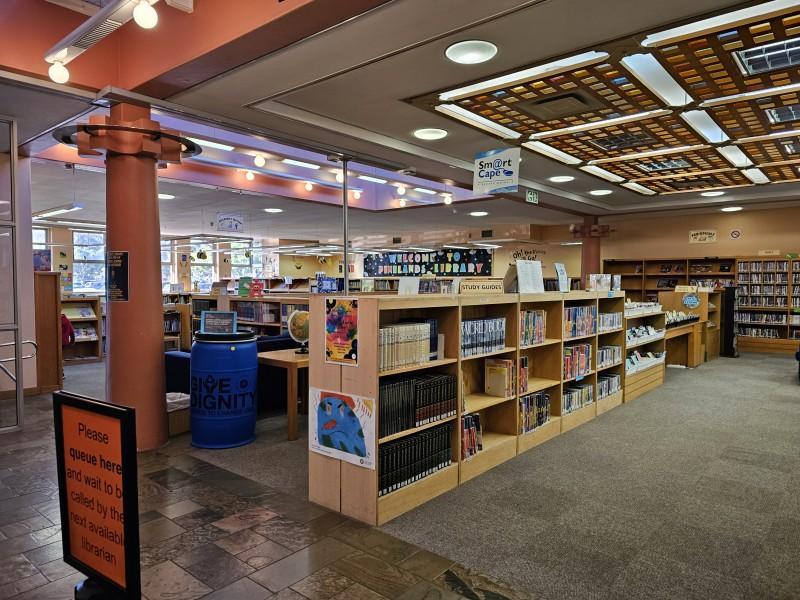
PHOTOS FROM ORIGINAL BOOK
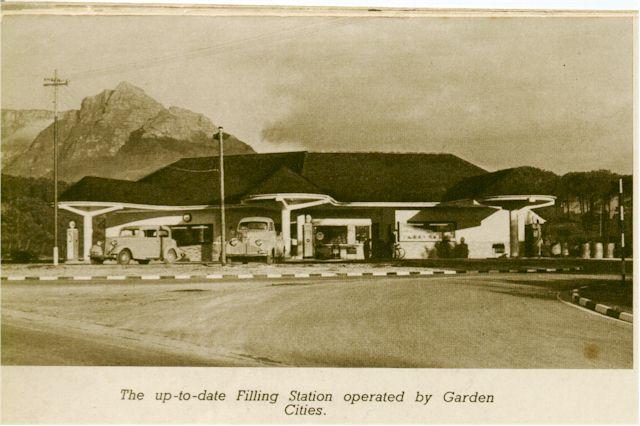
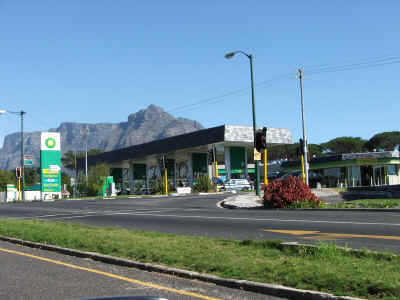
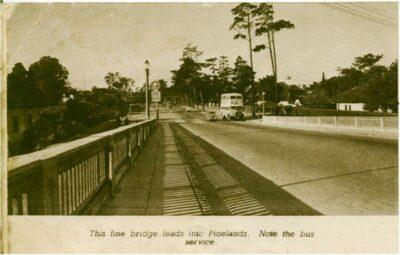
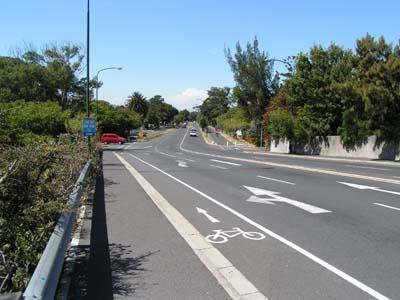
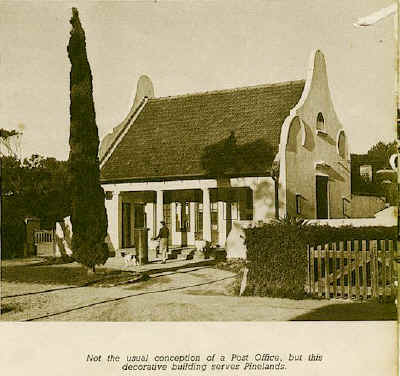
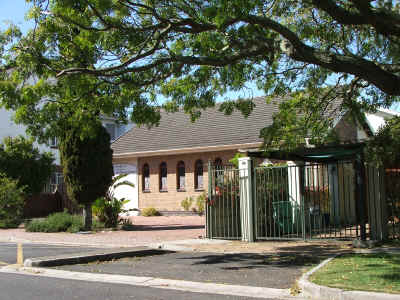
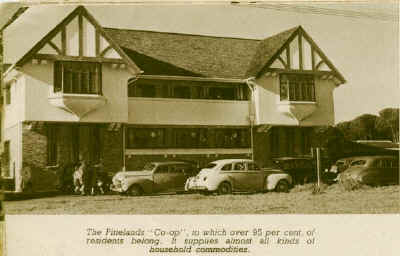
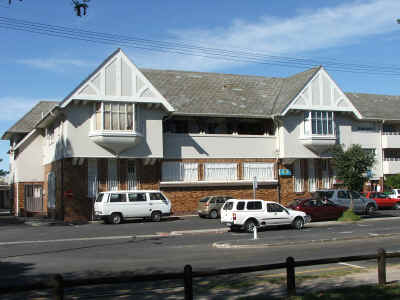
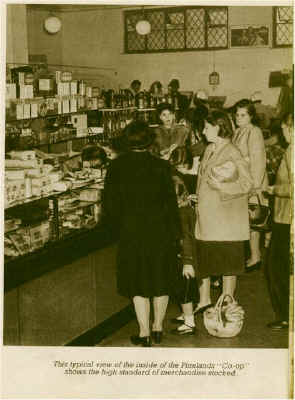



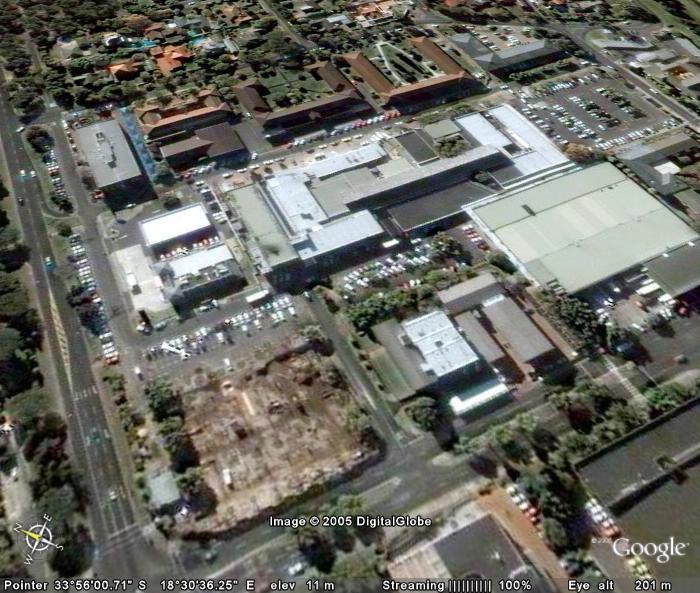
MY FULL SET OF PHOTOS ON FLICKR
OLD WOODEN BRIDGE
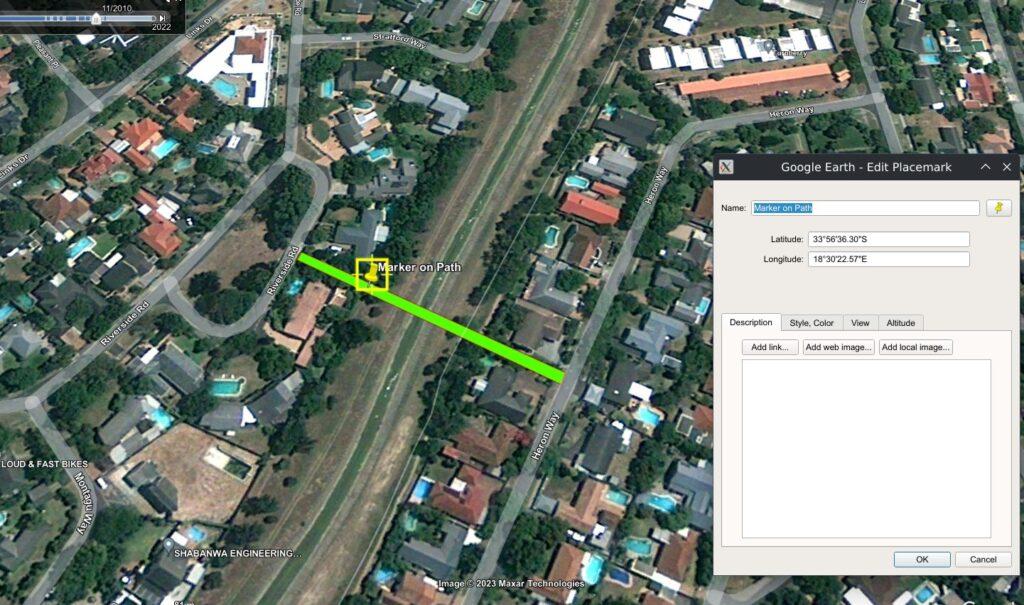
Not many will remember this (photo above) as it was in the late 1960’s, but there was an alley way between the houses where the green bar indicates. I seem to remember the bridge was made of massive wooden sleepers bound with thick wire, and had two wires strung along the sides as sort of protective barriers. I think the bridge across Nightingale Way is dated around 1963, so this old wooden bridge was probably doing daily duty up to that date.
If you look on a map like Google Maps, where property boundaries are shown, you’ll actually see the space still shown between the properties where the alley way ran on both sides of the river. That would be between numbers 26 and 28 Riverside.
You can find the spot along the canal path at -33.943435S, 18.506314E, although there is absolutely nothing that can be seen of what was once there, as the bridge was already gone by the time the river was turned into a canal.

